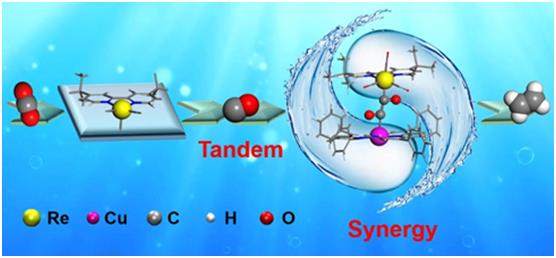The photocatalytic conversion of CO2 into C2+ products such as ethylene is a promising path towards the carbon neutral goal, but remains a big challenge due to the high activation barrier for CO2 and similar reduction potentials of many possible multi-electron transfer products.
In a study published in Journal of American Chemical Society, the research group led by Prof. CAO Rong and Prof. HUANG Yuanbiao from Fujian Institute of Research on the Structure of Matter of the Chinese Academy of Sciences, reported a tandem photocatalysis strategy by construction of the synergistic dual sites in rhenium-(I) bipyridine fac-[ReI(bpy)(CO)3Cl] (Re-bpy) and copper-porphyrinic triazine framework (PTF(Cu)).
The researchers developed an effective tandem photocatalysis strategy to support conversion of CO2 to ethylene by construction of the synergistic dual sites in rhenium-(I) bipyridine fac-[ReI (bpy)(CO)3Cl] (Re-bpy) and copperporphyrinic triazine framework [PTF(Cu)]. With these two catalysts, they produced a large amount of ethylene at a rate of 73.2 μmol g-1 h-1 under visible light irradiation. Ethylene cannot be obtained from CO2 by use of either component of the Re-bpy or PTF(Cu) catalysts alone. With a single catalyst, only monocarbon product CO is produced under similar conditions.
In the tandem photocatalytic system, the CO generated at the Re-bpy sites is adsorbed by the nearby Cu single sites in PTF(Cu), and this is followed by a synergistic C-C coupling process which ultimately produces ethylene.
 Based on the analysis of the in situ diffuse reflectance infrared Fourier transform spectroscopy (DRIFTS) spectra and density functional theory (DFT) calculations, the researchers photoreduced CO2 to Re-bpy-CO* over the Re-bpy, from which some of the CO can be desorbed and moved to the nearby PTF(Cu) where it is adsorbed by the single-atomic Cu site to form PTF(Cu)-CO*.
Based on the analysis of the in situ diffuse reflectance infrared Fourier transform spectroscopy (DRIFTS) spectra and density functional theory (DFT) calculations, the researchers photoreduced CO2 to Re-bpy-CO* over the Re-bpy, from which some of the CO can be desorbed and moved to the nearby PTF(Cu) where it is adsorbed by the single-atomic Cu site to form PTF(Cu)-CO*.
Besides, the C-C coupling occurred in the synergy of the intermediates PTF(Cu)-CO* and Re-bpy-CO* to form Re-*CO-CO*-Cu, which was finally reduced and released as ethylene with multistep proton-coupled electron-transfer (PCET) processes. DFT calculations demonstrated that the coupling process between PTF(Cu)-*CO and Re-bpy-*CO to form the key intermediate Re-bpy-*CO-*CO-PTF(Cu) is vital to the C2H4 production.
This study provides a new pathway for the design of efficient photocatalysts for photocoversion of CO2 to C2 products via a tandem process driven by visible-light under mild conditions.

Tandem photoreduction of CO2 to ethylene through a dual site-synergistic catalytic system by construction of the synergistic dual sites in rhenium-(I) bipyridine fac-[ReI(bpy)(CO)3Cl] (Re-bpy) and copper-porphyrinic triazine framework (PTF(Cu)). (Image by Prof. CAO’s group)
Contact:
Prof. CAO Rong
Fujian Institute of Research on the Structure of Matter
Chinese Academy of Sciences
E-mail: rcao@fjirsm.ac.cn